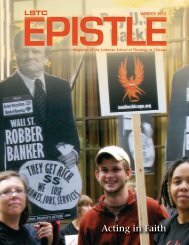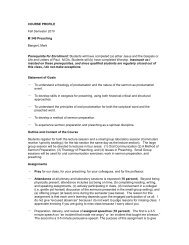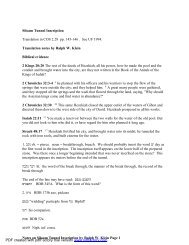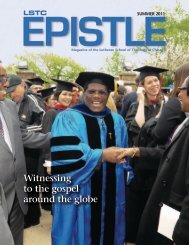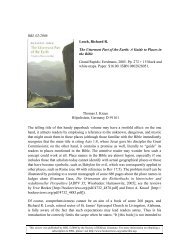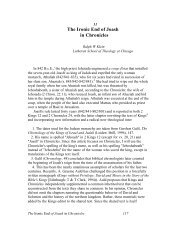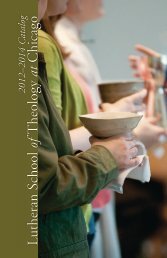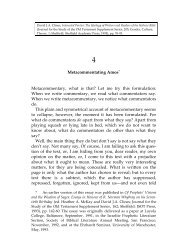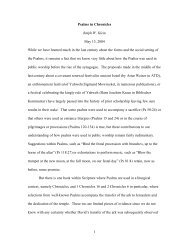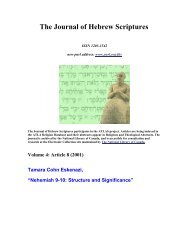Download this PDF file - University of Alberta - Journal Hosting
Download this PDF file - University of Alberta - Journal Hosting
Download this PDF file - University of Alberta - Journal Hosting
Create successful ePaper yourself
Turn your PDF publications into a flip-book with our unique Google optimized e-Paper software.
“IN CONVERSATION WITH ODED LIPSCHITS” 37stage in the history <strong>of</strong> the community and on the other the division isdetermined quite self-evidently along lines other than geographical.Whatever we make <strong>of</strong> Hanson’s theory <strong>of</strong> disenfranchised Levites, thefact that he sees them carrying a torch for Deutero-Isaiah suggests thatthey were not originally out <strong>of</strong> sorts with the Babylonian community,since part, at least, <strong>of</strong> Isaiah 40-55 must still be understood as addressedto that community whether or not the prophet was physically presentthere or in Judah (as Barstad has argued).Contemporary evidence, I would therefore maintain, presents avery different picture from the normal view. Where, then, does thelatter come from? Oded does not tell us where he gets it from, but formost it is, <strong>of</strong> course, the early chapters <strong>of</strong> Ezra. Closer examinationsuggests that things are not so simple, however.First, the only explicit evidence for tension with the Judeancommunity comes from Ezra 3:1-4:5, a passage which differs from allothers in Ezra 1-6 in not even purporting to be based on archivaldocuments. In 3:3 we are told that those engaged in the rebuilding <strong>of</strong>the temple “set the altar in its place, for fear was upon them because <strong>of</strong>the peoples <strong>of</strong> the lands” and <strong>this</strong> seems to be resumed in 4:4 where “thepeople <strong>of</strong> the land discouraged the people <strong>of</strong> Judah and made them afraidto build.” While it is more usual for the plural form <strong>of</strong> 3:3 to refer t<strong>of</strong>oreigners, the familiar singular form <strong>of</strong> 4:4 suggests that <strong>this</strong> is meantto refer to those in the land who were not part <strong>of</strong> the so-called golahcommunity. Whichever way it is interpreted in detail, however, the factremains perfectly clear that it differs from the usage in the genuinelycontemporary writings <strong>of</strong> Haggai and Zechariah. At Hag. 2:4 the phraserefers without any doubt to the very community that the prophet isencouraging to engage in the rebuilding: “Yet now take courage, OZerubbabel, says the Lord; take courage O Joshua, son <strong>of</strong> Jehozadak,the high priest; take courage all you people <strong>of</strong> the land, says the Lord; work,for I am with you ….” This is the very opposite <strong>of</strong> the usage in Ezra 3and 4. Somewhat similarly, in Zech. 7:5 we find, “Say to all the people <strong>of</strong>the land and the priests, When you fasted and mourned in the fifthmonth, etc.” Admittedly, it is not clear (as in principle it is not clear inHaggai) whether the reference is to the returned exiles or to those whohad remained in the land, or to the two combined without distinction.What is clear, however, is that here too it is the community focussed onthe temple that is addressed, not some alternative hostile element in thepopulation. The conclusion is obvious. The language <strong>of</strong> Ezra 3:3 and4:4 reflects the usage <strong>of</strong> a much later editor, by whose time the phrasehad come to have negative overtones. It cannot be used to analyse thestate <strong>of</strong> relations between the various people groups at the time <strong>of</strong> thereturn itself, and it does not provide evidence <strong>of</strong> tension between thetwo communities.Similarly, the section at the start <strong>of</strong> Ezra 4 about the “adversaries<strong>of</strong> Judah and Benjamin” whose <strong>of</strong>fer <strong>of</strong> help is rebuffed by the Judeansis difficult to evaluate historically. My own view is that there is somesound tradition behind <strong>this</strong>, and that it relates to inhabitants from thenorth (Samaria), not to the exilic Judean community at all. Certainly thatis how it seems to have been understood by the later editor whoinserted the “dischronologized” account in the remainder <strong>of</strong> chapter 4



